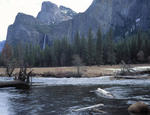
NPS/N. Bernard
DEATH VALLEY, CA – One year ago today, on July 31st, 2019, a Navy Super Hornet jet crashed near Rainbow Canyon in Death Valley National Park, killing the pilot and injuring several visitors who were viewing the aircraft training at low altitudes through the canyon. Over the last year, park and Navy officials have worked together to pay tribute to the pilot, Lieutenant Commander Charles Z. Walker, and remove debris from the area near the Father Crowley Vista Point.
This month, the park installed a new exhibit overlooking Rainbow Canyon to educate visitors on the military aircraft training history in the area. The exhibit includes a description of Lieutenant Commander Walker’s dream of being a fighter pilot, his prestigious career, and his numerous service medals and awards.
Rainbow Canyon, commonly called Star Wars Canyon, is part of the R-2508 Complex which the military has utilized since 1930s. The California Desert Protection Act, which expanded Death Valley National Park, called for continuation of military overflights. The park continues to play an important role in training pilots and equipment.
Visitors travel from around the world to photograph and watch aircraft training a low altitudes and high speeds at this location in the park. Star Wars Canyon’s popularity has grown in the last several years. This increased interest, driven by photography and aviation enthusiasts on social media, draws crowds to the location. Several visitors at the viewpoint suffered non-life-threatening injuries from flying debris after the crash.
Military flights in the area were briefly suspended during the investigation but have resumed.
After the crash, crews meticulously collected debris near the Father Crowley Vista Point. Cleanup efforts continued for nearly six months. The area around Padre Point, near the site of the crash, was closed to all visitation during the crash investigation and debris removal. Summer heat and high winds challenged cleanup efforts at times. Padre Point, a high point which overlooks Rainbow Canyon and Panamint Valley, reopened to the public in February 2020.
“We hope this wayside exhibit will encourage visitors to honor Lieutenant Commander Walker’s legacy and learn more about the military testing flights while visiting the overlook,” said Superintendent Mike Reynolds. “We are also grateful for the hard work of so many people in the hours, days, and months after the crash—from first responders tending to visitors injured by the explosion to crews removing debris from the area.”


